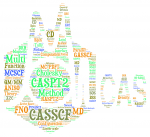Citation:

Date Published:
2016/02/15Abstract:
In this report, we summarize and describe the recent unique updates and additions to the Molcas quantum chemistry program suite as contained in release version 8. These updates include natural and spin orbitals for studies of magnetic properties, local and linear scaling methods for the Douglas–Kroll–Hess transformation, the generalized active space concept in MCSCF methods, a combination of multiconfigurational wave functions with density functional theory in the MC-PDFT method, additional methods for computation of magnetic properties, methods for diabatization, analytical gradients of state average complete active space SCF in association with density fitting, methods for constrained fragment optimization, large-scale parallel multireference configuration interaction including analytic gradients via the interface to the Columbus package, and approximations of the CASPT2 method to be used for computations of large systems. In addition, the report includes the description of a computational machinery for nonlinear optical spectroscopy through an interface to the QM/MM package Cobramm. Further, a module to run molecular dynamics simulations is added, two surface hopping algorithms are included to enable nonadiabatic calculations, and the DQ method for diabatization is added. Finally, we report on the subject of improvements with respects to alternative file options and parallelization.

